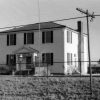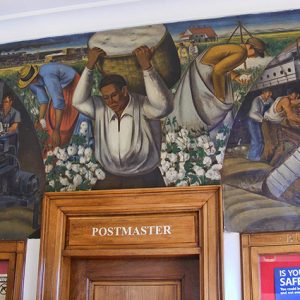calsfoundation@cals.org
Dardanelle Agriculture and Post Office
The Dardanelle Agriculture and Post Office is a 1938 U.S. Postal Service structure in Dardanelle (Yell County). A mural there painted by artist Ludwig Mactarian was financed through the U.S. Treasury Department’s Section of Painting and Sculpture (later renamed the Section of Fine Arts), a Depression-era stimulus project that promoted public art. The building was listed on the National Register of Historic Places on August 14, 1998.
U.S. congressman David D. Terry notified the postmaster for the county seat for northern Yell County in June 1936 that $60,000 in federal money was set aside for land acquisition and construction of a new facility for the town. A few months later, Dardanelle’s Post-Dispatch reported that the U.S. Treasury Department was purchasing five lots on the northeast corner of the intersection of Front and Locust streets for $5,000. Almost a year later, on August 12, 1937, the Post-Dispatch reported that demolition of the 1913 Armour Gray Grocery and Market Building was practically complete, clearing the way for construction of the new facility.
On September 23, the newspaper announced that the Linebarger and Fraser firm, which already had completed new post office buildings at Springdale (Washington and Benton counties) and Monticello (Drew County), was the low bidder for the Dardanelle project, with a contract price of $43,323. The new building would be a one-story structure with a basement that would have six large rooms for use by federal agencies. The Federal Revenue Department had an office there, as did the county and home demonstration agents. On June 2, 1938, the Post-Dispatch reported that the building, constructed for a total of $44,923, opened for business the previous day. A formal dedication, featuring an address by Congressman Terry, was held on July 27.
Included in the construction costs was $660 to finance a mural for the new Agriculture and Post Office Building at Dardanelle. On August 20, 1938, Edward B. Rowan, Section superintendent, invited New York artist Ludwig Mactarian to submit designs for the mural. Mactarian, who was born in 1910 in Armenia, immigrated to the United States at age ten, learning his craft in New York City. On October 20, Mactarian mailed Rowan a rough sketch for the Dardanelle mural, “the theme of which, is the three phases of the cotton industry—cotton growing, manufacture and export.” The Section approved the sketch on October 22 and gave Mactarian permission to proceed and, two months later, acknowledged receipt of his two-inch-scale color sketch of the mural. For some reason, Mactarian’s contract was not completed until December 15, prompting a terse January 9, 1939, letter to Rowan seeking payment. A first payment of $200 was approved on February 3, 1939.
On May 27, Mactarian wrote Rowan that the Dardanelle mural would be completed by the end of June, and he submitted a photograph of the full-sized painting. Mactarian’s second payment of $200 was approved on June 12, and the artist received approval to install the completed mural nine days later. On July 5, Mactarian notified Rowan that he and John Robertson, who painted a mural for the new Nashville (Howard County) post office, were heading south to install their works. He next wrote Rowan from Dardanelle on July 29: “Everything went well on the installation of my mural at Dardanelle. The townspeople seem pleased and interested in the decoration and think the subject most appropriate as they live and die by cotton here.” Dardanelle postmaster Joe D. Gault followed up with an August 5 letter confirming installation: “We have received many favorable comments from our patrons here concerning the mural.”
Mactarian again contacted Rowan in an August 16 letter pleading for his final payment, calling himself “dead broke.” His final payment of $260 was approved two days later.
Mactarian’s mural remains an integral part of the Dardanelle Agriculture and Post Office, a building that in the early 1990s was threatened with closing in favor of a new facility outside of its historic downtown location. The post office remains in this building in the twenty-first century, though the University of Arkansas Agricultural Extension Office is no longer located there.
For additional information:
“Arkansas Post Office Murals.” University of Central Arkansas. http://uca.edu/postofficemurals/home/ (accessed September 8, 2021).
Arkansas Post Office Mural Records. Arkansas State Archives, Little Rock, Arkansas.
“Contract Awarded for New Federal Building.” Post-Dispatch, September 23, 1937, p. 1.
“Contract for New P.O. to Be Let Sept. 16th.” Post-Dispatch, August 12, 1937, p. 1.
“Dardanelle Agriculture and Post Office.” National Register of Historic Places nomination form. On file at Arkansas Historic Preservation Program, Little Rock, Arkansas. Online at http://www.arkansaspreservation.com/National-Register-Listings/PDF/YE0094.nr.pdf (accessed September 8, 2021).
“Dardanelle Is to Have New Federal Building.” Post-Dispatch, June 25, 1936, p. 1.
“Government Pays for Federal Building Site.” Post-Dispatch, July 15, 1937, p. 1.
“New Federal Building Is Now Serving Public” Post-Dispatch, June 2, 1938, p. 1.
“New Federal Building Location Announced.” Post-Dispatch, August 13, 1936, p. 1.
Smith, Sandra Taylor, and Mark K. Christ. Arkansas Post Offices and the Treasury Department’s Section Art Program, 1938–1942. Little Rock: Arkansas Historic Preservation Program, 1998. Online at http://www.arkansaspreservation.com/News-and-Events/publications (accessed September 8, 2021).
 Architectural Styles
Architectural Styles Early Twentieth Century, 1901 through 1940
Early Twentieth Century, 1901 through 1940 Historic Preservation
Historic Preservation Post Office Art
Post Office Art Dardanelle Post Office Art
Dardanelle Post Office Art 



Comments
No comments on this entry yet.